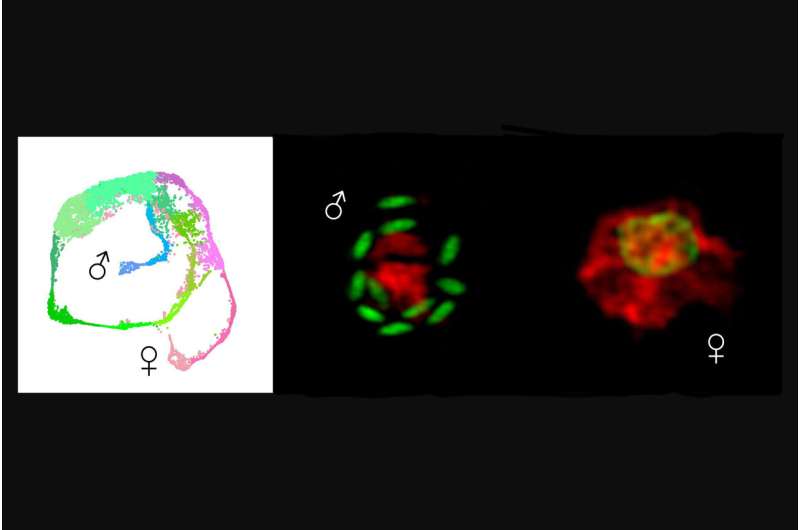This article has been reviewed according to Science X's editorial process and policies. Editors have highlighted the following attributes while ensuring the content's credibility:
fact-checked
peer-reviewed publication
trusted source
proofread
How deadly parasites choose to be male: Researchers reveal gene expression across the life cycle of Cryptosporidium

The single-cell parasite Cryptosporidium is a leading cause of deadly diarrheal disease in young children, and a recent outbreak in the United Kingdom highlights how vulnerable the water supply is to this pathogen.
There are no effective drugs or vaccines, making this an important organism to study. The parasite infects the cells that line the intestines and engages in both asexual and sexual replication, which researchers suspect are both critical to sustained infection and transmission.
But the mechanism by which the parasite becomes male or female is unknown. "These parasites do not have sex chromosomes, like the human X or Y," says Katelyn A. Walzer, a postdoctoral fellow in the Striepen Lab in Penn's School of Veterinary Medicine. "Revealing how they choose a sex is of fundamental biological interest and provides a new key target to block transmission and infection."
Walzer is the lead author of a study, published in Nature, that reveals the gene expression program of the entire Cryptosporidium life cycle.
Using RNA sequencing, the researchers profiled more than 9,000 parasites—from infected cell cultures and mice—and developed the Cryptosporidium single-cell atlas, which reveals what genes are expressed at which points across the life cycle.
In a second major finding, researchers identified the earliest determinant of maleness, a gene called Myb-M.
"We show in this and other work that the sexual part of this life cycle is critical to infection, and blocking it through parasite contraception will block the infection," says senior author Boris Striepen. He says that by disrupting sex "we may be able to cure the disease or weaken the parasite to engineer a vaccine, so I think there's a really strong translational potential."
This builds on prior research that revised the life cycle to one with only three stages—a single asexual form, males, and females—whereas the prevailing literature proposed an additional, intermediate stage.
Walzer explains that Cryptosporidium infects people, often through contaminated water, in a sporelike form called an oocyst, which is resistant to water chlorination. Once in the intestine, parasites emerge from the spore to invade the epithelial cells that line the intestine and replicate within those cells before they leave and invade new intestinal cells.
This asexual cycle of invasion, replication, and egress occurs three times before the parasites differentiate into male and female gametes, and then fertilization leads to new oocysts.
Walzer says that, through this new research, "we have a full understanding of all the genes that are involved in each of those processes, from invasion to growth to division to then forming the invasive form again."
She says this atlas offers a detailed blueprint of every aspect of the parasite's biology and its potential vulnerabilities. Cryptosporidium makes a lot of proteins that are necessary to invade and manipulate the host, and the team's work parses these different proteins based on the timing with which their genes are read.
"The invasive forms of the parasite come with a battery of weapons that allow them to invade and overtake our cells, and this arsenal is assembled with remarkable time precision," Striepen says. He compares it to a car factory assembly line where new components are made just in time, and Walzer has developed a list of all the parts and when they come together.
Walzer says researchers in this field are excited about the Cryptosporidium single-cell atlas because they can look up the context in which the genes they're studying are expressed. This is very helpful information for those searching for drug and vaccine targets, as it helps predict the phases of infection in which the parasite may be most vulnerable.
By engineering parasites to express fluorescence, the researchers also reached their second key finding: the discovery of the transcription factor, meaning a protein that regulates gene expression, which is responsible for maleness, Myb-M.
"When we forced the parasite to make this factor at any point, each and every parasite turned male, and when we took it away no males developed. Importantly, both of these manipulations blocked the infection," Walzer says.
Striepen says this finding underlines the value of parasite sex as a target for intervention, and Walzer says this study also "leads us up to knowing the complete catalog of genes required for parasite sex, providing important clues to mechanism and translational targets."
Walzer says that in future research she is interested in following up on how Myb-M drives male fate and in understanding more generally how regulation of transcription drives stage-specific differences to orchestrate the complex life cycle.
More information: Katelyn A. Walzer et al, Transcriptional control of the Cryptosporidium life cycle, Nature (2024). DOI: 10.1038/s41586-024-07466-1
Journal information: Nature
Provided by University of Pennsylvania





















